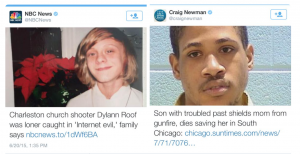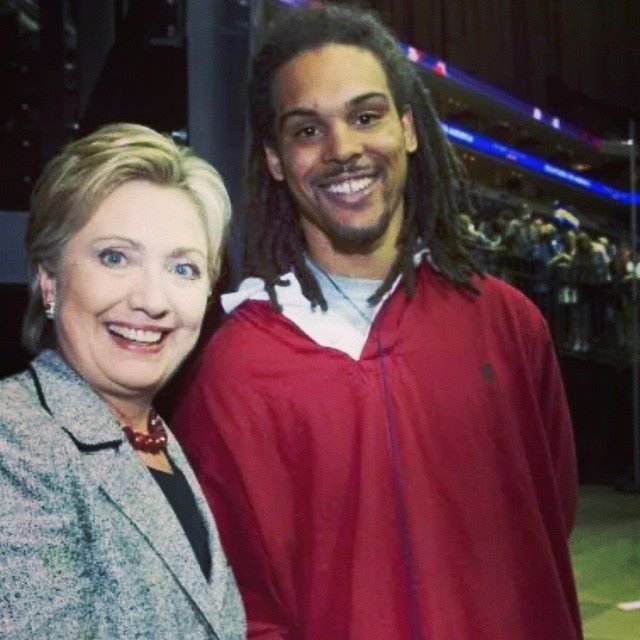More Media More Power- I got you Braxton Winston
There is a Huffington Post article that addresses the racial biases in the media’s display of young black men. In the Huffington Post article about the treatment of black Americans in the media in comparison to white Americans, they gave examples of white criminals being glorified while African American victims are criminalized. One such example was of a 25 year old black male that was murdered. The headline of one news site they mention was “Montgomery’s latest homicide victim had history or narcotic abuse, tangles with the law.” Again this African American male was the VICTIM, so why did his life struggles matter ? In this example, the audience is pitted against the victim even though he wasn’t the bad guy of the situation. When African American male victims are seen in a negative light it reinforces the stereotypes associated with them. In doing this, the audience is also convinced that he is to blame because his past hints that he could’ve gotten involved with the wrong crowd. On the other hand, white men who have committed a crime are displayed as misguided. If the criminal is white, only his accomplishments will be mentioned. This makes the audience sympathize with the criminal no matter how major the crime. For example, look at the pairing of these two images created by Maisha Johnson. Of the two pictures displayed one is a hero and the other is a murderer. On the left is Dylann Roof, he is responsible for the Charleston church shooting. The right side is a picture of James Jones, who died protecting his mom from gunfire.

NBC News displays Roof as innocent young boy who fell victim to tragedy, whereas James Jones died protecting his family and is displayed in a mug shot. The article title doesn’t even mention his name but the article on Roof mentions his name and immediately tries to soften his crime. Using a mugshot for James Jones implies that his past was the only option for his future. In other words, he was headed for more trouble with the law even though in this article he was the victim. The way the media portrays certain people serves as a baited hook that captures readers by unlocking their implicit bias. The audience’s implicit bias promotes sales even when the meat of the article differs from the headline and featured images.
Implicit Bias refers ” to the attitudes or stereotypes that affect our understanding, actions, and decisions in an unconscious manner.” (Kirwan) More plainly it is the thoughts you associate with certain things and people before you get to know them or analyze them. For example, seeing a black man in a store and grabbing your bag to prevent him from stealing from it. The man may not have done anything to provoke your response but your brain has been trained to see black men that way, which makes you respond accordingly.
The “baited hook” effect is present in the Charlotte Observers report on the protests that broke out in response to the police shooting of Keith Lamont Scott. A picture went viral of one protester in particular and it serves as the baited hook.

Here’s a picture of Winston where isn’t displayed in a stereotypical manner. He is actually portrayed as an active participant in a conversation with police. He is wearing a button down shirt and his hair is up.
This is the very first image of Winston that is used for the Charlotte Observer’s article.
The very first picture is of a shirtless and saggy pants Braxton Winston. To some, this picture would be enough to convince them that Winston was inciting violence simply because that is the stereotype associated with Winston’s appearance. His appearance is that of the stereotypical black male. However, the article shows Winston in a different light. In their article, Olivia Daniels and AJ Naddaff explain Winston’s influence and aid in bettering police relations within communities. The man displayed in the picture is introduced for who he is and the audience realizes that they were wrong about Winston. He is different from the stereotypes. Regardless of whether a person thought negatively of Winston prior to reading the article, they are on his side by the end of the article.
By the end of the article, Winston’s character is rebuilt but which message sticks with the reader more ? The side effect of using the “baited hook” method is that the same implicit bias that hooked the reader is reinforced. The reader finishes the article but is only left with the bait and all other narratives are lost. So while the audience knows of Winston’s good work, they’ll still only see a black man and clutch their bag if they come across him in person.
Also shout out to J Cole for the title idea 🙂
Work Cited :
Olivia Daniels and AJ Naddaff Correspondents. “Fist Raised, He Faced off with Police. Here’s Why This Davidson Grad Protests.” Charlotteobserver. N.p., 30 Dec. 2016. Web. 04 Apr. 2017.
Wing, Nick. “When The Media Treats White Suspects And Killers Better Than Black Victims.”The Huffington Post. TheHuffingtonPost.com, 14 Aug. 2014. Web. 04 Apr. 2017.
“Understanding Implicit Bias.” Kirwan Institute for the Study of Race and Ethnicity. N.p., n.d. Web. 06 Apr. 2017.
Images
Johnson, About Maisha Z. “8 Ways the Media Upholds White Privilege and Demonizes People of Color.” Everyday Feminism. N.p., 02 Dec. 2016. Web. 06 Apr. 2017.
Siner, AP: The Charlotte Observer/Jeff. “Braxton Winston Pic from Charlotte Protests.” ABC News. N.p., 04 Oct. 2016. Web. 12 Apr. 2017.
the featured picture came from davidson’s twitter.

Margaret,
This is a really important post– I think the topic of how black men are portrayed in the media (particularly compared to white men) is a topic that doesn’t get enough attention. That said, I think it would be interesting if you could find and incorporate more examples into your post. I know there are tons of examples of this out there, and your post is good just going into detail about the examples you’ve presented, but something to think about is how you could add another example (or two) to really hammer your point home.
Margaret
I loved the subject of this post because my friends and I constantly discuss the representation of Black men vs. White men in the media. You touched on a lot of great points, between the comparison of Dylan roof and the Black man that raised his life to save his mother’s, and then the media representation of Braxton Winston. One suggestion that I have for your next post is to focus more heavily on the wording in the media posts. By highlighting certain words to be compared, you give the reader no choice but to realize that there is a stark contrast in the representations of White and Black men. Also, something to think about, if you compiled media representations of White and Black men, you could further emphasize this difference. Also note the it Keith’s full name is Keith Lamont Scott, not Keith Lamar Scott.
Margaret,
I really enjoyed this post because I really felt as though your voice was shown in these one-thousand characters. I would try and find more examples from different types of media to help back up your claim, which I believe is sadly true. I think with the Winston part of your post, you could touch on how an image changes ones perspective, maybe by touching on Isherwood. If you could disect the wording differences a little more, I think you would have a home run article. I look forward to reading your new version soon,
Pingback: online gay sex games